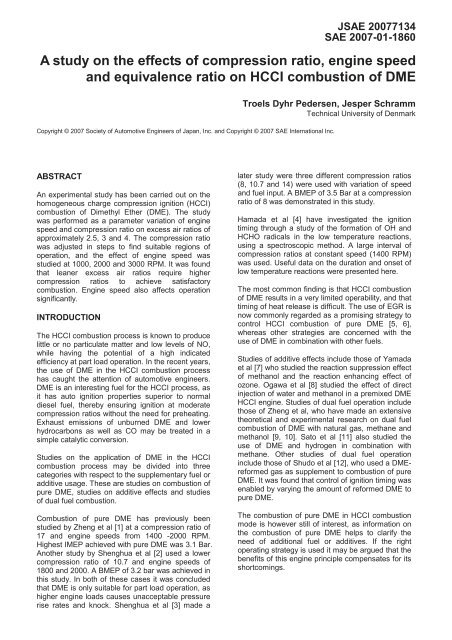Troels Dyhr Pedersen.indd - Solid Mechanics
Troels Dyhr Pedersen.indd - Solid Mechanics
Troels Dyhr Pedersen.indd - Solid Mechanics
You also want an ePaper? Increase the reach of your titles
YUMPU automatically turns print PDFs into web optimized ePapers that Google loves.
JSAE 20077134<br />
SAE 2007-01-1860<br />
A study on the effects of compression ratio, engine speed<br />
and equivalence ratio on HCCI combustion of DME<br />
<strong>Troels</strong> <strong>Dyhr</strong> <strong>Pedersen</strong>, Jesper Schramm<br />
Technical University of Denmark<br />
Copyright © 2007 Society of Automotive Engineers of Japan, Inc. and Copyright © 2007 SAE International Inc.<br />
ABSTRACT<br />
An experimental study has been carried out on the<br />
homogeneous charge compression ignition (HCCI)<br />
combustion of Dimethyl Ether (DME). The study<br />
was performed as a parameter variation of engine<br />
speed and compression ratio on excess air ratios of<br />
approximately 2.5, 3 and 4. The compression ratio<br />
was adjusted in steps to find suitable regions of<br />
operation, and the effect of engine speed was<br />
studied at 1000, 2000 and 3000 RPM. It was found<br />
that leaner excess air ratios require higher<br />
compression ratios to achieve satisfactory<br />
combustion. Engine speed also affects operation<br />
significantly.<br />
INTRODUCTION<br />
The HCCI combustion process is known to produce<br />
little or no particulate matter and low levels of NO,<br />
while having the potential of a high indicated<br />
efficiency at part load operation. In the recent years,<br />
the use of DME in the HCCI combustion process<br />
has caught the attention of automotive engineers.<br />
DME is an interesting fuel for the HCCI process, as<br />
it has auto ignition properties superior to normal<br />
diesel fuel, thereby ensuring ignition at moderate<br />
compression ratios without the need for preheating.<br />
Exhaust emissions of unburned DME and lower<br />
hydrocarbons as well as CO may be treated in a<br />
simple catalytic conversion.<br />
Studies on the application of DME in the HCCI<br />
combustion process may be divided into three<br />
categories with respect to the supplementary fuel or<br />
additive usage. These are studies on combustion of<br />
pure DME, studies on additive effects and studies<br />
of dual fuel combustion.<br />
Combustion of pure DME has previously been<br />
studied by Zheng et al [1] at a compression ratio of<br />
17 and engine speeds from 1400 -2000 RPM.<br />
Highest IMEP achieved with pure DME was 3.1 Bar.<br />
Another study by Shenghua et al [2] used a lower<br />
compression ratio of 10.7 and engine speeds of<br />
1800 and 2000. A BMEP of 3.2 bar was achieved in<br />
this study. In both of these cases it was concluded<br />
that DME is only suitable for part load operation, as<br />
higher engine loads causes unacceptable pressure<br />
rise rates and knock. Shenghua et al [3] made a<br />
later study were three different compression ratios<br />
(8, 10.7 and 14) were used with variation of speed<br />
and fuel input. A BMEP of 3.5 Bar at a compression<br />
ratio of 8 was demonstrated in this study.<br />
Hamada et al [4] have investigated the ignition<br />
timing through a study of the formation of OH and<br />
HCHO radicals in the low temperature reactions,<br />
using a spectroscopic method. A large interval of<br />
compression ratios at constant speed (1400 RPM)<br />
was used. Useful data on the duration and onset of<br />
low temperature reactions were presented here.<br />
The most common finding is that HCCI combustion<br />
of DME results in a very limited operability, and that<br />
timing of heat release is difficult. The use of EGR is<br />
now commonly regarded as a promising strategy to<br />
control HCCI combustion of pure DME [5, 6],<br />
whereas other strategies are concerned with the<br />
use of DME in combination with other fuels.<br />
Studies of additive effects include those of Yamada<br />
et al [7] who studied the reaction suppression effect<br />
of methanol and the reaction enhancing effect of<br />
ozone. Ogawa et al [8] studied the effect of direct<br />
injection of water and methanol in a premixed DME<br />
HCCI engine. Studies of dual fuel operation include<br />
those of Zheng et al, who have made an extensive<br />
theoretical and experimental research on dual fuel<br />
combustion of DME with natural gas, methane and<br />
methanol [9, 10]. Sato et al [11] also studied the<br />
use of DME and hydrogen in combination with<br />
methane. Other studies of dual fuel operation<br />
include those of Shudo et al [12], who used a DMEreformed<br />
gas as supplement to combustion of pure<br />
DME. It was found that control of ignition timing was<br />
enabled by varying the amount of reformed DME to<br />
pure DME.<br />
The combustion of pure DME in HCCI combustion<br />
mode is however still of interest, as information on<br />
the combustion of pure DME helps to clarify the<br />
need of additional fuel or additives. If the right<br />
operating strategy is used it may be argued that the<br />
benefits of this engine principle compensates for its<br />
shortcomings.

















